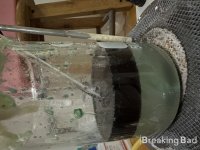- Language
- 🇬🇧
- Joined
- Jan 15, 2023
- Messages
- 371
- Reaction score
- 189
- Points
- 43
I will answer all in one post.
Acids are used a lot for the inertness of the temperature when an aqueous solution of glycidate is added dropwise, the reaction took place immediately and the free ketone was immediately distilled with steam. That is, the initial reaction temperature is about 110 degrees, when an aqueous solution of glycidate is added dropwise, it drops to 108 degrees.
Also, an excess of acid makes the mixture homogeneous; in such a mixture, hydrolysis occurs instantly.
The acid can be optimized based on the fact that we need to dissolve sodium phosphates, make the mixture homogeneous and sufficiently heat-resistant.
12 ml of water per gram of glycidate is needed for the steam distillation of p2p, my research has given that 10-11 ml of water is needed to distill 1 ml of p2p, that is, I provided some margin for complete isolation of the ketone from the reaction mass.
For this hydrolysis, it is better to use glycidate rather than sodium salt, in which case much less acid can be used, and there is also no consumption of acid for the formation of sodium phosphate.
This technique gives the maximum yield, plus all the ketone is steam distilled and can be used without purification.
Set the dropping at a speed so that the temperature of the mixture does not fall below 105 degrees, that is, everything goes almost automatically, the more acid and the more powerful the heating, the higher the rate of dropping. I have a technique for scaling, but it is purely commercial (conversion from 5 to 500 kg of glycidate per reaction), so it will not be published.
Acids are used a lot for the inertness of the temperature when an aqueous solution of glycidate is added dropwise, the reaction took place immediately and the free ketone was immediately distilled with steam. That is, the initial reaction temperature is about 110 degrees, when an aqueous solution of glycidate is added dropwise, it drops to 108 degrees.
Also, an excess of acid makes the mixture homogeneous; in such a mixture, hydrolysis occurs instantly.
The acid can be optimized based on the fact that we need to dissolve sodium phosphates, make the mixture homogeneous and sufficiently heat-resistant.
12 ml of water per gram of glycidate is needed for the steam distillation of p2p, my research has given that 10-11 ml of water is needed to distill 1 ml of p2p, that is, I provided some margin for complete isolation of the ketone from the reaction mass.
For this hydrolysis, it is better to use glycidate rather than sodium salt, in which case much less acid can be used, and there is also no consumption of acid for the formation of sodium phosphate.
This technique gives the maximum yield, plus all the ketone is steam distilled and can be used without purification.
Set the dropping at a speed so that the temperature of the mixture does not fall below 105 degrees, that is, everything goes almost automatically, the more acid and the more powerful the heating, the higher the rate of dropping. I have a technique for scaling, but it is purely commercial (conversion from 5 to 500 kg of glycidate per reaction), so it will not be published.
- Language
- 🇬🇧
- Joined
- Feb 25, 2024
- Messages
- 68
- Reaction score
- 5
- Points
- 8
Good morning sir.
I know nothing about chemistry.
I have a question. Distill immediately after addition. Was dehydroxylation completed in such a short period of time?
When I use phosphoric acid to reflux 5449, when I add phosphoric acid to the 5449 solution, it immediately separates into an oil layer. But he was not finished and needed to reflow for more than 4 hours.
Is the final product using your approach P2P?
What is the profit rate for this P2P to convert sodium borohydride into methamphetamine?
I know nothing about chemistry.
I have a question. Distill immediately after addition. Was dehydroxylation completed in such a short period of time?
When I use phosphoric acid to reflux 5449, when I add phosphoric acid to the 5449 solution, it immediately separates into an oil layer. But he was not finished and needed to reflow for more than 4 hours.
Is the final product using your approach P2P?
What is the profit rate for this P2P to convert sodium borohydride into methamphetamine?
- Language
- 🇬🇧
- Joined
- Jan 15, 2023
- Messages
- 371
- Reaction score
- 189
- Points
- 43
I have distillation with water vapor P2P from boiling mixture of glycidate \ phosphoric acid \ water, or by microwave irradiation until the excretion of carbon dioxide is stopped and then distillation with steam. If you have a separation, then you can use more acid / water, I had this because of the loss of sodium phosphates, but usually I worked with free glycidate. Amin's crop is 70+ percent of the theory (it may be higher if you observe the conditions and get the maximum output of the intermediate Imin), with recovery amination in sodium borhydrid, from the p2P.
- Language
- 🇺🇸
- Joined
- Jan 9, 2024
- Messages
- 48
- Reaction score
- 7
- Points
- 8
Hello, I would like to ask about what you said about using glycidyl salt instead of sodium salt. How can you tell the difference between these two salts? Is CAS the same?

